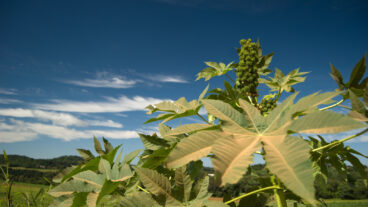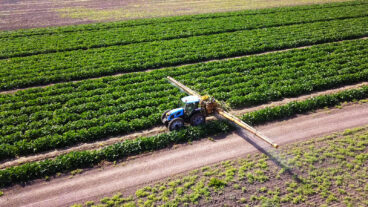Leading scientists are coming to Israel for a UN-sponsored conference on the world’s drylands.
‘Making the desert bloom” is one of the axioms in David Ben-Gurion’s remarkable legacy which has fired the imagination of Israeli farmers, international donors and a Zionist movement for more than half a century. Israel’s founding prime minister put his money where his mouth was and stunned the entire Jewish people in 1953 when he left his head-of-government position to move to a remote kibbutz, Sde Boker, in the Negev desert.
There he would live out his days trying to bring about Isaiah’s prophesy: “The desert and the parched land will be glad; the wilderness will rejoice and blossom.”
On November 6, Sde Boker will once again be the focus of attention in Israel when Ben-Gurion University’s Jacob Blaustein Institutes for Desert Studies co-hosts a major, four-day international meeting entitled “Deserts and Desertification – Challenges and Opportunities.” Its partner – the United Nations Convention to Combat Desertification – constitutes the key international mechanism for addressing one of the planet’s most egregious ecological scourges.
This constitutes the first time that the UN has joined in fully supporting an Israeli academic initiative. Dozens of leading scientists, politicians and field workers – from Nigeria’s minister of environment to diplomats from Jordan and Turkey to public interest activists from Burkina Faso and Mali will come to Israel to talk about the state of the world’s drylands, how to address the direct and indirect drivers of desertification. Among the topics that will be discussed will be Israel’s experience in restoring its degraded drylands.
The gathering is hardly an esoteric academic exercise for there is grave cause for concern. Desertification, or the degradation of soils in the drylands, is a global problem of enormous dimensions.
A recent comprehensive report sponsored by the World Bank – the “Millennium Ecosystem Assessment” estimates that 10 percent-20% of the world’s drylands suffer from significant degradation – (That’s 4 million-8 million square miles of lands that can no longer produce yields according to their natural potential.) Some 400 million of the world’s poorest people are negatively affected. The symptoms are often seen in the nightly news: famine, refugees, pervasive poverty and even violence. Sadly, international efforts to address the myriad causes have been patently inadequate and in many regions desertification is expanding.
What makes desertification especially tragic is the fact that it is one of the few global ecological problems for which clear solutions exist. Israel, to a great degree, serves as a living proof that when a country makes soil conservation, irrigation and sustainable desert agriculture and forestry a national priority, trend need not be destiny.
Indeed, when Israel achieved independence, the Negev desert extended up to Gedera, today a southern suburb of Tel Aviv. Due to centuries of overgrazing, deforestation and poor soil stewardship, the northern Negev, once a highly productive region, had largely turned into a wasteland. When Jews around the world read this week’s Torah portion about Abraham’s personal journey through the desert to the promised land, what emerges is a nomadic lifestyle that was based on an equilibrium with the region’s harsh environment. This equilibrium that was lost for many centuries. In a sense, in 1948 the Jewish people had to quickly relearn how to live in harmony with their arid homeland.
Even with its meager resources as a nascent developing country, Israel set about to reclaim its desert heritage. During the 1950s, water infrastructure projects were built that delivered water from the rainy north to the desiccated south. Settlements were established that first invented and then expanded drip irrigation technologies to produce prosperous, local agricultural economies. The Jewish National Fund succeeded in planting trees on dry and salty lands that professional forestry literature had long since written off. Grazing was organized, with seasonal allocations made to ensure that the land’s carrying capacity was not exceeded.
The Israeli experience was not without its mistakes. Aquifers were overpumped. Sometimes the wrong crops were planted. For too long a paradigm of “conquering the desert” rather than “living with the desert” prevailed. But the impulse of transforming the degraded heartlands of Israel remained a central national commitment and the trial-and-error process began to produce results.
Today, Sde Boker boasts a campus for students who come from around the world to pursue graduate degrees in Desert Studies, researching topics from climate-sensitive agriculture to algae cultivation in the deserts.
It has long been noted that humanity’s most acute problems do not rate coverage in the media, presumably because people are too weary to hear about the pathologies of starvation, poverty and ecological devastation. The solutions to these problems have an even harder time generating headlines. In response to the severity of the situation in much of the world’s drylands, the United Nations declared 2006 to be the International Year of Deserts and Desertification, expecting all countries in the world to raise international awareness about the issue. But the declaration hardly made it into the back pages of the newspapers. The conference at Sde Boker will try to send a message to Israelis as well as to the 35 countries that will be sending representatives: With ingenuity and respect for ecological constraints, the drylands can be a source of economic opportunity and spiritual edification.
Ultimately, it is important to remember that Israel is not only internationally newsworthy as a focal point for Middle Eastern turbulence. Ours would be a better world if it could acknowledge that the tiny Jewish state has tackled one of the planet’s key ecological problems and succeeded like no other country in the region.
The November conference in Sde Boker is actually taking place but a few hundred meters from David Ben-Gurion’s stark and powerful grave on the edge of the cliff overlooking the Zin wilderness. Yet it offers an even more compelling, living memorial to the Old Man’s ideals.
(Reprinted with permission from The Jerusalem Post)












